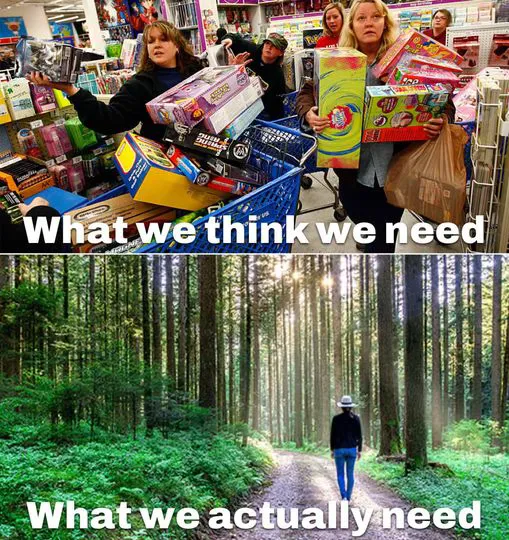A Personal Backstory
From the late 1960s and throughout the 70s, environmental concerns were prominently covered in the international media. Special influences include such publications as Rachel Carson’s Silent Spring (1962), the Club of Rome’s The Limits to Growth (1972), and Paul R. and Anne H. Ehrlich’s The Population Bomb(1968). Unfortunately, a conservative resurgence in the 1980s, largely motivated by ideology and politics, managed to successfully deny, ignore, and circumvent essential public discussion of any topics that challenged the conventional pro-growth economic paradigm.
In June, 1970, I completed my doctoral degree at Northwestern University in Evanston, Illinois. Three months later my wife, Bettye, three young sons, and I began a two-day road trip from Mississippi to Minneapolis. Our conveyances consisted of a Chevy station wagon and a U-Haul truck towing our VW camper. Everything we owned was on the move.
After having arrived, unloaded and unpacked our belongings, we spent family time studying the Twin Cities. Soon afterwards I assumed my teaching position in the University of Minnesota’s music department, and Bettye began giving piano lessons in her home studio. Our family continued exploring many city, state, and national parks, especially with summer road-trip vacations.
This background information is meant to explain our initial interests in becoming a environmentally conscious family. A banner with the statement “The solution to pollution is a theology of ecology!” hung prominently on the wall of our country-styled kitchen’s dining area, effectively as a reminder of our ecological commitment.
We voluntarily began recycling used glass and metal items, which required crushing cans and breaking bottles we placed in two normal-sized metal trash cans. By the time they were full, I could barely lift the glass container into our station wagon. We also had to deliver them to a recycling center 8-miles distance from our home. On two occasions, when driving over the facility’s scattered shards of metal and glass to reach the large dumping area, we experienced punctured tires.
I don’t recall how long that voluntary practice lasted before municipal curbside pickup began in the early 1990s, but we tried to manage recycling most approved materials for many years, exclusive of plastics. It was a welcomed relief to finally have access to officially-sponsored collection programs in all surrounding suburbs. Of course, the ultimate solution to managing waste products requires reducing consumption of natural sources.
What’s wrong with consuming more than needed for living sufficiently?
There’s a reason for sharing this personal learning experience. Regardless of our meager efforts at reducing waste products, including composting food scraps for home gardens, we’ve nevertheless used an inordinate amount of energy, time, and finances in procuring and discarding materials derived from Mother Nature.
Over the past two decades Bettye and I have grown so aware of our life-long consumption—as individuals and as a species—that we’ve had to learn how to cope psycho-emotionally. For anyone concerned about humanity’s deleterious impacts on natural systems, accepting moral responsibility may require transitioning through the Kübler-Ross “5 Stages of Death: Denial, Anger, Bargaining, Depression, and Acceptance”. Typically, we fluctuate between depression (sadness) and acceptance, and occasional flashes of anger when learning of fellow humans’ harmful behaviors and actions.
Mostly due to ignorance, either intentional or unintentional, we moderns are captive to a socio-cultural pro-growth economic system that employs coercive strategies in maximizing consumption of goods and services. For certain, it’s a dead-end strategy with tragic implications, seemingly incapable of changing a dangerous trajectory spiraling towards a potential socio-ecological collapse. How so? A brief explanation will suffice.
Referencing the previous post featuring the book, Ishmael, we learned that Mother Nature is the authentic capital upon which all living beings depend for sustenance. In contrast, Mother Culture has taught us apex-predator humans that the Earth’s bounty is ours for the taking, to use and abuse as we wish in fulfilling all our basic needs. As for obtaining our desired wants, it’s estimated that approximately 10% of the global population in G7 countries consume about 40% of the Earth's biological productivity.
Indeed, our profligate overconsumption is substantiated by scientific data indicating the Earth’s ability to provide sustenance for all lifeforms is in overshoot—by a large margin. As a whole, humanity is consuming nature 1.7 times faster than the biocapacity can regenerate, the equivalent of using 1.7 Earths annually. But note this: If the entire global population consumed at the U.S. level, it would represent the equivalent consumption of 5.1 Earths!
What’s more, while the global biocapacity amounts to around 1.5 global hectares per person, the global population’s per-person Ecological Footprint is estimated at 2.7 global hectares per person, of which the Carbon Footprint is 60%.
Adding to such dire statistics is this reality: Humans alone comprise 36% of all mammal biota, and our domestic animals (livestock)comprise another 60%. These combined percentages leave only a 4% portion representing land and sea wild mammals. In stark contrast, prior to the Neolithic era (12,000 to 9,000 BCE), the ratio of humans to wild mammals in the Paleolithic era was estimated at around 1% of all mammals. Obviously, such a imbalanced scenario does not bode well for future sustainability.
Such wildly-contrasting percentages indicate how grossly imbalanced we are in relation to the rest of the Earth’s biota. Since the beginning of civilization in the Neolithic era, we humans have contributed to around an 85% loss of wild mammals. Within America’s past 200 years or so, two examples stand out: the wholesale wanton extinction of the North American passenger pigeon and the near-eradication of bison, not only for food and pelts, but also as a sport.
I imagine that you also find it difficult to accept the harsh cruelty humans have inflicted—and continue perpetrating—on other humans and non-humans. But how does this harsh reality relate to total consumption?
The high-consumption footprint of an average middle-class American
To illustrate excessive consumption, let’s consider the lifetime consumption of an average, solidly middle-class American couple with two children supported through college age. My wife and I, both in our late 80s, have three sons, ages 60-66, and a rough estimate of our lifetime consumption to date should be fairly representative. I think you’ll find the total consumption mind-boggling. We do!
In referencing the image posted at the top, you’ll observe what ChatGPT created in response to my request, which included major items most families need. For our family, this includes shelter (5 average-sized homes), transportation (23 vehicles), home furnishings and equipment, clothing, food, trash, and so on. I suspect many possessions have been overlooked, including items used once and discarded, as when traveling, eating out, and so on.
For an idea of possessions owned by families in other countries, consult Web Urbanist. I find the 19th-century photos of native American families effective in illustrating minimal possessions, like the Flathead family pictured below.

Click on the image to enlarge.
The following statistics further explain the extent of per-person consumption in the United States:
Energy: In 2023, total U.S. primary energy consumption per capita consumption was about 279 million British thermal units (MMBtu).
Food: Each year, the average American consumes around 1,885 pounds, nearly a ton per year! For the 321,000,000 people in the U.S., the amount is 302.5-million tons of food per year.
Water: The average person uses 101.5 gallons of water daily, including bathing/showering, flushing, washing clothes, dishes, face, and hands, and drinking (including bottled water).
Clothing and Footwear: A 2022 survey found that an average American spends about $1,400 per year on apparel plus $700 on footwear.
Shelter and Other Goods/Services: Average annual expenditures reached $77,280 in 2023, including housing, transportation, food, Insurance/ pensions, healthcare, and entertainment.
Wrap Up
I think we’ve covered this topic sufficiently for now. What I’d like to leave with you is a rationale for developing greater awareness of the excessive overconsumption experienced daily. Not only your consumption, but that of others and society as a whole. This includes awareness of waste products, especially the litter observed everywhere, especially in large cities. On our frequent walks Bettye and I maintain a lookout for litter, usually collecting items to be placed in the nearest trash container.
Also, when attending social events, I encourage you to observe signs of unnecessary and excessive consumption, including celebrations when decorations are prominently displayed, and often composed of non-biodegradable synthetic materials, like balloons. I think you’ll be amazed—and disturbed—by what you experience.
One principal recommendation I have for young adults striking out on their own and fully committed to independent living is this: Travel as lightly as possible through life. Exploring new opportunities and experiences is so much easier when unencumbered with lots of stuff. Moreover, living with fewer encumbrances can help hone essential skills for coping with any socioecological challenges that arise.
Undoubtedly, the ongoing interrelated effects of climate change will pose the supreme challenge, including extreme weather conditions that will increasingly lead to more droughts, wildfires, floods, and storms—and fewer arable areas means less food sources. Also we must not overlook the possibility of worsening geopolitical conflicts and the increasing chances for endangerment and extinction of many species. And the list goes on.
My apologies for once again closing on a low note. It just seems necessary due to the short timeframe available to awaken enough global citizens to our current reality and take constructive measures, beginning with the following homework assignment:
Homework assignment: Make preparations now for continuing to survive and live a long, fulfilling life, with the goal of accepting reality and remaining grateful for living in such exciting times. It isn’t too late, but it will be soon enough if we don’t act collectively in hastening a major de-growth transition, beginning with reducing consumption!

Click on the image to enlarge.